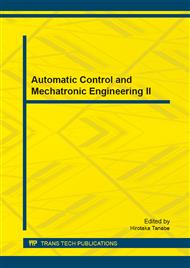p.409
p.414
p.418
p.423
p.427
p.431
p.436
p.442
p.446
Equation Model of Stabilization of Low Damped Astatic Systems
Abstract:
The paper deals with the stabilization of low damped astatic systems. They show a low value of a relative damping and consequently a high resonance rise of amplitude frequency response. If astatism occurs in an automatic control system, the situation becomes complicated due to the exhaustion of a phase safety of astatic element. In order to achieve the stabilization, a filter with rejections has been designed. The filter is characterized by rapid rejections of logarithmic frequency characteristics that eliminate resonance rise of a low damped astatic system. A functional model of a discrete filter was created to attest the properties of the filter with a continuous low damped astatic system. Experiments have proved the suitability of the filter application. The method of the filter utilization, the stability of the low damped astatic system as well as the stability assessment by the operator W will be described in the paper.
Info:
Periodical:
Pages:
427-430
Citation:
Online since:
September 2013
Authors:
Price:
Сopyright:
© 2013 Trans Tech Publications Ltd. All Rights Reserved
Share:
Citation:


